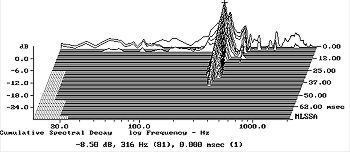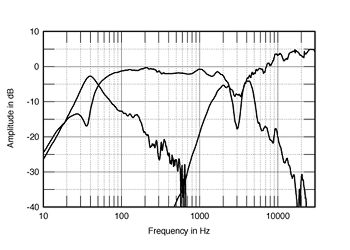| Columns Retired Columns & Blogs |
Sonus Faber Concerto Grand Piano loudspeaker Measurements
Sidebar 3: Measurements
The Sonus Faber Concerto Grand Piano appears to be of average sensitivity, my B-weighted figure of 87dB/2.83V/m agreeing with the manufacturer's specification. Its impedance plot (fig.1) implies that the speaker is a kind load for the partnering amplifier, dropping below 8 ohms only in the lower midrange and featuring a relatively low phase angle. The "saddle" at 40Hz in the magnitude trace indicates the tuning of the passive radiator (it behaves just like a reflex port, but with the added benefit that it is less transparent to internal-airspace resonant modes). The rather peculiar shape of the traces in the low treble implies that the crossover is rather more complicated than the simple first-order type specified.

Fig.1 Sonus Faber Concerto Grand Piano, electrical impedance (solid) and phase (dashed) (2 ohms/vertical div.).
There are very slight wrinkles visible in the impedance traces around 150Hz and just above 300Hz. Examining the cabinet's vibrational behavior with a simple plastic-tape accelerometer revealed just one resonant mode, at 316Hz (fig.2). This was evident on all surfaces, but may well be low enough in level that its subjective effect will be small. I note that, in his auditioning, MF noticed nothing untoward in this frequency region.

Fig.2 Sonus Faber Concerto Grand Piano, cumulative spectral-decay plot of accelerometer output fastened to center of cabinet back wall. (MLS driving voltage to speaker, 7.55V; measurement bandwidth, 2kHz.)
Fig.3 shows, from left to right, the individual outputs of the tweeter, woofer, and passive radiator. The latter's response looks just like that of a reflex port—a sharply defined bandpass centered on the tuning frequency of 40Hz, coincident with the minimum-motion point in the woofer's response—and although there is a suggestion of a peak at 160Hz, this is well suppressed. The woofer's output is smooth throughout the midrange, but the behavior of the drive-units in the crossover region is complex. Perhaps there is a notch filter present to compensate for some aspect of the woofer's behavior at 3kHz. The woofer is still contributing significantly to the speaker's output up to 5kHz or so. The tweeter also appears to have a notch at 3kHz in its output, and then has a rising top-octave response, at least on this axis.

Fig.3 Sonus Faber Concerto Grand Piano, acoustic crossover on tweeter axis at 50", corrected for microphone response, with the nearfield woofer and passive radiator responses plotted below 300Hz and 1kHz, respectively.
- Log in or register to post comments




































